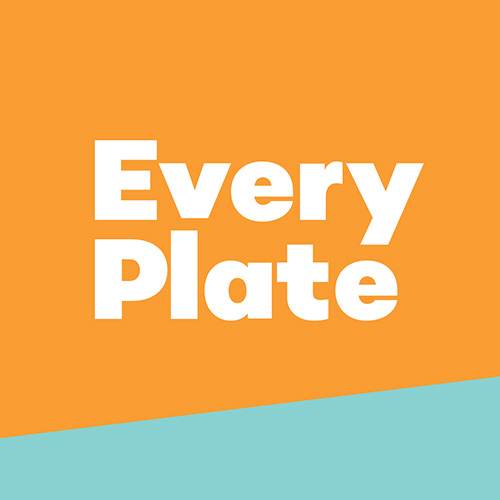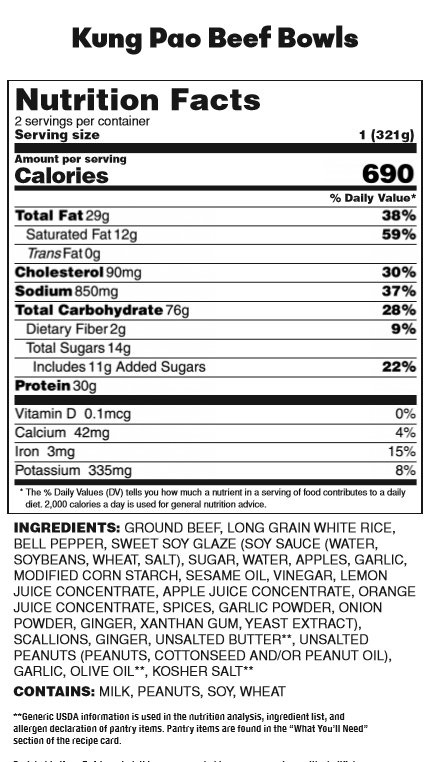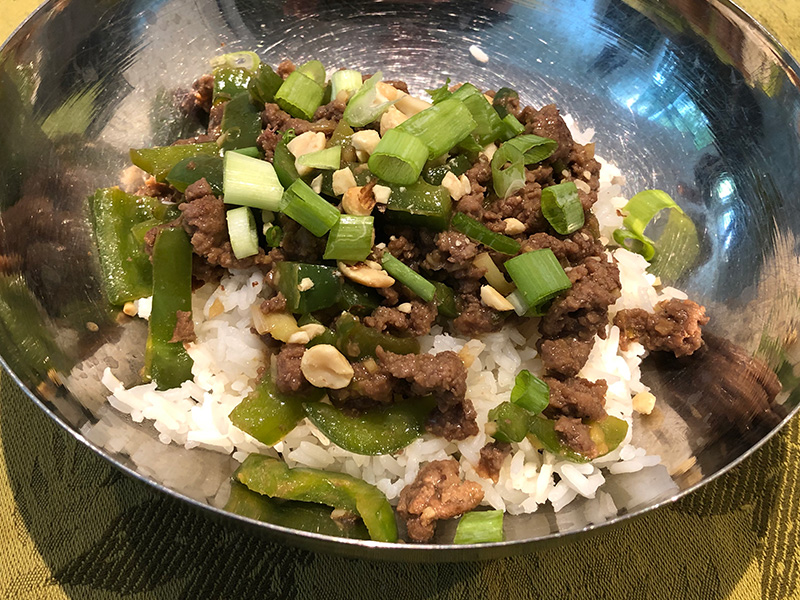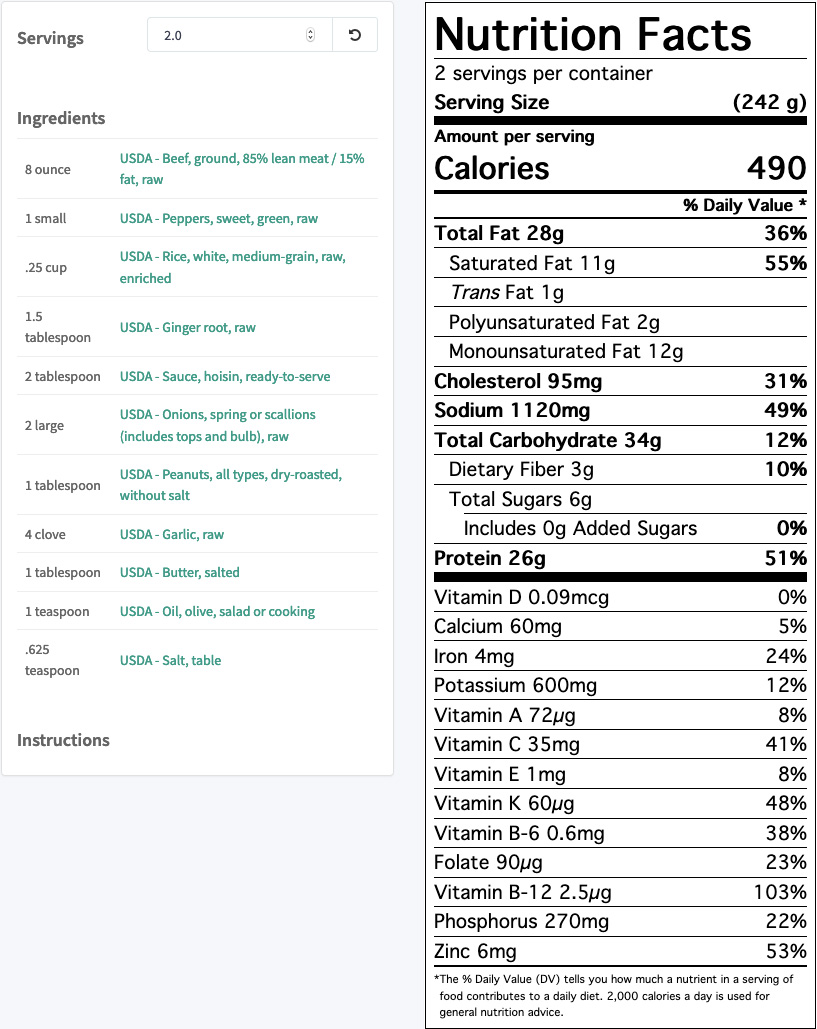Dr. Gourmet's Food Reviews
EveryPlate Food Delivery Service, Part 2: Kung Pao Beef Bowls

After making the Creamy Dijon Chicken, we made the Kung Pao Beef Bowls. For this dish we received
* an 8-ounce package of 85/15 ground beef
* 1 small green pepper
* a small package of white rice (about 1/4 cup)
* a chunk of fresh ginger about 1 x 1.5 inches
* a packet of "sweet soy glaze" containing 1-2 Tablespoons of a dark brown liquid
* a package of 2 scallions
* a small packet of about 1 Tablespoon of dry roasted peanuts, and
* a head of garlic
The nutrition breakdown for the meal, as provided by EveryPlate, is as follows:

Note that the listed amount of sodium is 850mg per serving, and it's one of the reasons that my wife chose (she thought) to skip that week. [See last week's review for the problems we had with ordering from this company.] We would not knowingly choose a dish containing that much sodium, especially when meals much lower in sodium were available.
Yet this is one of the meals that was shipped to us, so despite the fact that I could not taste it, my wife (a competent cook) did the honors for this dish. As with last week's recipe from EveryPlate, this one (spoiler alert) is pretty terrible.
If you've read our reviews of other meal/ingredient delivery services, you may have noticed that EveryPlate, like nearly all other such services, likes to have the home chef add salt to the dish. Nearly all the time.
For example: to cook the white rice for this dish, you are instructed to rinse the white rice and then place the rice and a cup of water into a small saucepan. Along with a "pinch" of salt. Later on, when the rice is done, you are instructed to fluff the rice with a fork - and add salt.
You start cooking the main portion of the dish by adding "a drizzle of oil" to a pan and adding the diced green bell pepper. But of course you add salt and pepper to that bell pepper.
I'll note at this point that the "What You'll Need" section of the written instructions specifies "Koster salt/black pepper, Vegetable Oil (5 tsp/10tsp) and Butter (1 Tbsp/2 Tbsp)." The "5 tsp/10tsp" and "1Tbsp/2 Tbsp" are for 2 servings and 4 servings, respectively. Given the number of teaspoons and the number of "drizzles" we figured that "a drizzle of oil" was equivalent to 1 teaspoon of oil.
Add the whites of the scallions, the minced garlic, and the minced ginger to the bell pepper and saute for 30 seconds.
Add the 85/15% ground beef to the pan and ADD MORE SALT AND PEPPER. Brown the ground beef until cooked through. The instructions say that "If there's excess grease in your pan, carefully pour it out."
There wasn't all that much oil in the pan after sauteing the ground beef - how much is "excess"? How would you pour it out, and into what? Wouldn't congealed beef fat clog my kitchen's pipes?
No matter - there wasn't all that much "excess grease" in the pan, so we continued. We added the contents of the "sweet soy glaze" packet to the dish along with MORE SALT AND PEPPER. Stir well, and add 1 Tablespoon of butter, stirring until the butter is melted. (That butter, my friends, is about 150 calories all by itself.)
To serve, you fluff the rice with a fork, add YET MORE SALT (as I mentioned above), and divide the rice between two bowls. Divide the beef mixture and sprinkle the whole with the chopped, roasted peanuts as well as the green parts of the scallions.

Here the breakdown we did using FoodCare that estimates the contents of the various packets and includes the sodium added at home:

It should be no surprise that there's a good 30% more sodium in the nutrition information calculated for what actually goes into the dish than there is in the nutrition information as provided by EveryPlate. I no longer find that interesting. But the amount of sugar in the EveryPlate version is interesting.
A look at the ingredients list shows that the "sweet soy glaze" includes soy sauce, sugar, apples, lemon juice concentrate, apple juice concentrate, and orange juice concentrate. Other than the soy sauce, all of those ingredients are essentially sweeteners. Are they necessary to the flavor of the dish? Maybe - but maybe those added sweeteners wouldn't be necessary without all that salt.
Nutrition information aside, we wouldn't recommend this dish. While the rice is nice and fluffy, with every grain distinct, the beef is overly greasy and rather sweeter than it is savory even with its excess salt. The peanuts and green onions add a welcome bit of texture, but overall this is more like cheap, greasy Chinese food takeout than something you could be proud to have cooked at home.
Honestly, I think that you would be better off to simply stop at Panda Express than eating this meal. I can't imagine that anyone competent is actually working in the kitchen at EveryPlate, because these are just terrible recipes.
Make your own Kung Pao Beef at home with the same number of calories but less than half of the saturated fat and salt.
Next week: EveryPlate's Panko Ranch Pork Chops.
Posted: October 2, 2020
Sometimes you just can’t make it into the kitchen to cook. Dr. Gourmet has reviewed over 1,000
common convenience foods, ingredients, and restaurant selections so that you know what’s worth
eating – and what’s not.




